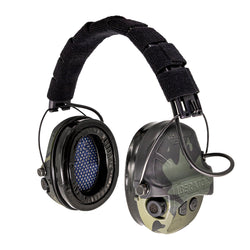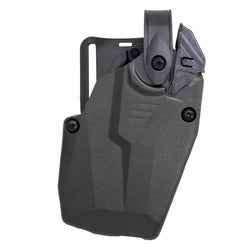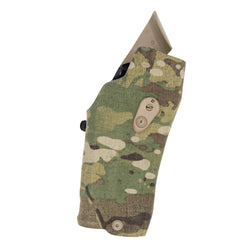Hiram Percy Maxim, the son of another Hiram Maxim, produced the first practical and successful suppressor. His father created machine guns, but Maxim Jr. created suppressors. He was a brilliant man who saw a future where military adoption of suppressors was possible.
In 1910, he produced a suppressor aimed at equipping the Springfield M1903, the rifle of choice for the United States military.
This signaled the rise of suppressors in the United States Military. Today, we’ll examine the history of suppressor use by military forces from the earliest days of their invention to the modern world.

The US Military and Suppressors: First Encounter
The first notable use of suppressors by the United States military happened before the American Expeditionary Force headed to Europe. General John Perishing was assigned to lead a punitive expedition into Mexico in response to a raid by Pancho Villa.

He had one section of snipers with silenced M1903 Springfield rifles. The suppressors were likely Maxim designs. Sadly, we don’t have any details on how this section was used or whether the suppressors made a difference.
World War 1 and Suppressors
World War 1 saw the clash of modern and old wars. Planes and motorized vehicles fought alongside horse-mounted cavalry. Machine guns sprayed lead into young Europeans, but soldiers still fought with knives and clubs when things got close. We also saw some very limited use of suppressors by British and German forces.

They both experimented with suppressors on their rifles, typically for reconnaissance troops who would only fire when necessary. The United States ordered suppressed M1903 rifles, but they didn’t make it to the war in time. Like the BAR, they made it to the dock but not on the ship before the war ended.
World War 2 and the Rise of Espionage and Special Operations
World War 2 saw a steep rise in the use of suppressed weapons. We also saw the birth of modern espionage, spymasters, and special operations, which required specialized weaponry, including suppressed weapons. The Allies, in particular, invested in suppressed weapons.

The Russian forces experimented with suppressors in the 1930s and adopted the Bramit silencer for the M91/30 Mosin Nagant rifle. This suppressor used replaceable wipes and was meant for use with specialized subsonic 7.62x54R ammunition. Scouts, NKVD troops, and snipers sued these suppressors.
The British forces had guns like the Welrod, a single-shot, integrally suppressed handgun chambering the .32 ACP cartridge. It was meant to be very quiet with a very limited report and was designed for close-range assassinations. The Brtis also produced the De Lisle carbine, a Lee Enfield converted to 45 ACP with an integral suppressor for special ops troops. There were also the famed suppressed Sten guns that armed early British special ops troops.

The Amercians armed their OSS agents and Special Ops troops with the .22LR semi-auto, integrally suppressed High Standard HDM. A gun that was personally picked by OSS head ‘Wild’ Bill Donovan. They also produced integrally suppressed M3 submachine guns. Springfield M1903 rifles with Maxim suppressors were used in the sniping role.
Vietnam: The Modern Silencer Is Born
Between World War 2 and Vietnam, not much changed in the world of suppressed military arms. In Vietnam, the United States faced a guerilla military force and a new type of warfare, further proving the need for special operations forces. As the need for special operations rose, the need for suppressors followed.

Modern companies like Sionics picked up the challenge of producing suppressed firearms alongside organizations like Naval Special Warfare. Suppressors were produced for the M14 and XM21 rifles. The M16 was soon suppressed. Special Ops troops adopted Uzis, Walthers, and the Swedish K, all with suppressors when possible. The Navy developed the Mk 22 Mod 0, a modern double action 9mm handgun designed to be suppressed and nicknamed the Hush Puppy.

Oddball-suppressed weapons also popped up. Attempts to create suppressed revolvers to clear rat holes were experimented with. This included unique integrally suppressed cartridges rather than suppressors attached to the barrel. Sionics created a straight pull bolt action M1 carbine in 9mm with an integrally suppressed barrel, which the Army purchased in small numbers. Experiments like the Silent Sniper Rifle aimed to throw a very big cartridge quietly.

The Vietnam War established suppressor use among snipers and special operations troops. This normalized the idea and carried it into a post-Vietnam War world.
Pre-GWOT Era
After Vietnam and before the GWOT, we had an era of relative peace punctuated by occasional short conflicts. In this era, engineers at Qual-A-Tech created the Nielsen device, which was one of the biggest contributions to suppressors and military use.
This device allowed short recoil-operated handguns to cycle reliably with a suppressor installed. Most handguns use some form of short recoil operation, which requires barrel movement.

Suppressors add weight to the barrel, which can inhibit that movement. A Nielsen device ensured service handguns could work with suppressors.
In the 1990s, the HK Mark 23 came to life. This massive .45 ACP handgun was designed to be the first offensive handgun and was fielded by SOCOM. It was absurdly accurate, durable, and reliable, and it wore a Knight’s Armament suppressor.
Suppressors in The GWOT
The Global War on Terror was another asymmetric warfare in which American forces dealt with guerillas. Special operations and snipers became force multipliers. There was no front line, so everyone was behind it. This is where we began to see suppressor use multiply considerably. Knights Armament suppressors became extremely popular on M4 and Mk 18 series rifles.
As the war raged, the rise of suppressors followed. Near the end, it wasn’t just special operations and snipers wielding suppressors. They filtered down to the standard grunt in small numbers. Designated marksmen in the Marine Corps were issued OPS Inc. suppressors for their Mk 12 rifles.

Near the end of the GWOT, the US Marine Corps conducted a massive experiment and equipped an entire battalion with suppressors. This experiment showed that suppressors made troops harder to locate and improved situational awareness and command and control for small unit leaders.
After the experiment, the Marine Corps decided to equip their combat arms forces with suppressors across the board.

The SU Army launched the Next Generation Squad Weapons contest. The NGSW program ended with a win by SIG and Vortex, and the new M7 rifle will be equipped with a suppressor. The American military’s main fighting forces are now fielding suppressors en masse, marking a major change in what the next battlefield will look, and sound like.
The Suppressed Warfighter
It’s been over a century since the US Military first fielded suppressors. They moved slowly, but finally, common sense took hold. Suppressed weapons offer numerous benefits to soldiers and Marines, and they seem firmly rooted in American equipment’s future.









